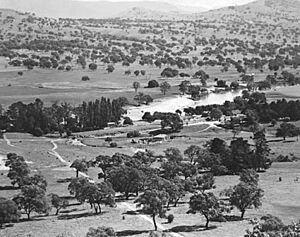Lanyon Homestead facts for kids
Lanyon is a very old and important farm, called a homestead, located just outside Canberra in the Australian Capital Territory. It's a place where people used to raise animals like sheep and cattle.
Contents
Exploring Lanyon's Past
The Lanyon area was first settled by Europeans around 1829. A man named Timothy Beard brought his cattle to graze on the grassy plains. He had arrived in Australia in 1806. After some time, he became a farmer, even though he didn't officially own the land. This was called being a "squatter." Timothy Beard had small huts near the Molonglo River and also where Lanyon homestead now stands. Later, as more land was officially given out, he had to leave the area. He then became an innkeeper in a place called Bringelly.
The Wright Family's Start
In 1833, James Wright and his friend John Hamilton Mortimer Lanyon arrived from London. They settled at Lanyon as squatters, meaning they farmed the land without owning it yet. James also brought his wife and five children. By 1835, they bought several pieces of land along the Murrumbidgee River. This river was then considered the edge of where people could legally settle.
The Wright and Lanyon families worked hard. They started an orchard, grew vegetables, and planted wheat. They also bought cattle and sheep and began a dairy farm. Many workers helped them, including people who had been sent to Australia as part of the justice system. By 1837, about thirty such workers were helping at Lanyon.
James's older brother, William, arrived in 1836 and bought land next to theirs. Sadly, William died in 1837 after a shooting accident. John Lanyon returned to England and passed away in 1841. James Wright married Mary Davis in 1838, and their first three children were born at Lanyon. However, James faced money problems and had to sell Lanyon in 1841. He then moved to a nearby farm called Cuppacumbalong. The Wrights had created a community at Lanyon with up to 60 people living and working there. The design of their buildings is said to remind people of James Wright's home area in England.
The Cunningham Family's Era
After the Wrights, a banker from Scotland named Andrew Cunningham bought Lanyon. He arrived in Sydney with his family in 1845. The Cunninghams built the main Lanyon homestead that we see today. They used local stones to build it in 1859. By the time Andrew Cunningham died in 1887, Lanyon had 25,000 sheep. The Cunninghams had also bought five other properties.
Andrew's sons, James and Andrew Jackson Cunningham, managed the properties together. James lived at Tuggeranong, and Andrew lived at Lanyon. In 1905, Andrew Jackson married Louisa Leman. They made the homestead bigger and redecorated it. Andrew died in 1913, and Louisa sold everything inside the house and moved back to Sydney. James Cunningham then moved his family from Tuggeranong to Lanyon in 1915.
The Field Family's Changes
After James Cunningham passed away in 1921, his son Andy looked after Lanyon until 1926. Then, the property was sold to Harry Osborne. In 1930, the Osbornes sold Lanyon to Thomas Field. The Field family owned many large farms in New South Wales and Queensland. They lived in Sydney but visited Lanyon often.
The Field family made big changes to Lanyon. They used modern farming methods and improved the pastures. They also started irrigating lucerne, which means they watered the crops using special systems.
By the late 1960s, the city of Canberra was growing quickly. This meant that large areas of farmland south of Canberra were needed for new developments. Lanyon was the biggest piece of privately owned land in the ACT. Thomas Field wanted to divide some of his 9,000 acres (about 36 square kilometers) into smaller blocks. However, the Australian government decided to buy Lanyon. Mr. Field was offered $1.875 million, but he wanted $33 million, which was what a private expert said the land was worth for city development.
This disagreement led to a big court case between Mr. Field and the Australian government. The government argued that their offer was fair. They were also worried that if Mr. Field won, it would set a difficult example for how much compensation should be paid for private land across Australia. In the end, the government bought Lanyon for $3.7 million in 1974. Around this time, the government also took back the farming leases for Lanyon, Cuppacumbalong Homestead, and Gold Creek Homestead.
Lanyon Today
After the government bought Lanyon, the homestead was turned into the Sidney Nolan Gallery. It opened to the public in 1975. This gallery showed a collection of paintings by a famous artist named Sir Sidney Nolan. A special building just for the Nolan collection was built on the grounds in 1980.
Today, Lanyon homestead has been carefully repaired and restored. It is now managed as a house museum by the ACT Government and the National Trust of Australia (ACT). It's still part of a working farm.
Lanyon Homestead faced a threat from the 2003 Canberra bushfires. These fires also threatened the nearby town of Tharwa. On January 18, 2003, as fires got closer to Canberra, a wedding was happening at the homestead. The fire situation became very serious, and Tharwa had to be evacuated. Firefighters bravely defended and saved Tharwa. Lanyon Homestead was not directly hit by the fire, but burning embers did fall on it. A single fire truck was there to spray water and protect the historic homestead. Given how old Lanyon is, this was certainly not the first time the property had faced bushfires.



